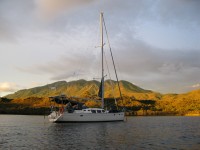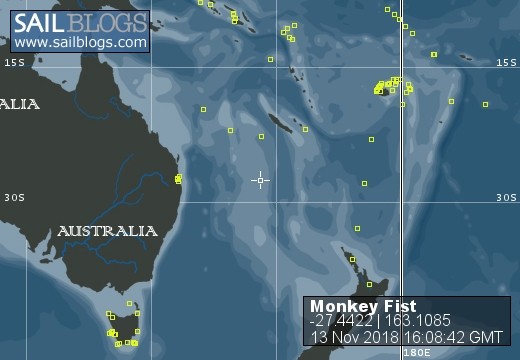
Monkey Fist

Who: Paul and Frances Tudor-Stack
Port: Darwin
Favorites
- Eyeglass Assist - Solomon Island Project
- OnTheNose
- PKA Products
- Lions Recycle For Sight
- Monkey Fist movie - Mexico to the Marquesas
- How to tie a Monkey's Fist
- Death in Paradise
- Raramuri
- Cruisers Comfort
- Diablo Canyon Nuclear Power Plant
- Fords Terror Time Lapse
- Galloping Gertie
- Gotz Guitar website
- Hawthorne Gallery
- Monkey Fist in Johnstone Strait
- Monkey Fist sailing in New Zealand
- Oki Islands, Japan - information
- Princess Louisa Inlet
- The Chichi Jima Incident
- Tsunami wave hits Brookings
13 November 2018 | Brisbane, Australia
04 November 2018 | On Passage - The Coral Sea, 480 MTG, 650 miles logged
28 October 2018 | Honiara, Solomon Islands
21 October 2018 | Shortland Islands, Western Province, Solomon Islands
18 October 2018 | Bay of 1,000 Voices, Choiseul., Solomon Islands
18 October 2018 | Bay of 1,000 Voices, Choiseul., Solomon Islands
15 October 2018 | Bay of 1,000 Voices, Choiseul, Solomon Islands
14 October 2018 | Pelau, Ontong Java, Malaita Province, Solomon Islands
14 October 2018 | Luaniua, Ontong Java, Malaita Province, Solomon Islands
14 October 2018 | Ontong Java Atoll, Malaita Province, Solomon Islands
03 October 2018 | Choiseul, Solomon Islands
02 October 2018
02 October 2018
02 October 2018
27 September 2018
27 September 2018
27 September 2018
27 September 2018
24 September 2018
24 September 2018
The Long Voyage Ahead
08 April 2017 | Barra de Navidad, Mexico

Our stay in Mexico and the Americas is quickly coming to an end. By the time we leave the shores of Mexico in less than 2 weeks, we will have been in this country for 6 months and in the North American continent and islands for coming on to 2 years.
The next stop should be Hiva Oa in the Marquesas Islands, French Polynesia, just shy of 3,000 nm or 6,000 kms to the south east of our present position (the red dashed line on the diagram show our intended route). It's not an insignificant distance, and for many sailors (as it will be for us) the longest passage they will ever undertake. If everything goes to plan it should take between 3 and 4 weeks, however as passages go, the challenges should not be as great as many other shorter passages.
There are basically three different legs to the voyage:- for the majority of the voyage we should be in the North Easterly trade wind belt experiencing winds blowing from aft (behind us) and steady but, in any event, between 15 to 35 knots. However we have to get there first. The latitude of Mexico means that we are the right distance from the Equator to be in the trade winds, however the influence of the American continental land mass results in less predictable and often diminished winds within a couple of hundred miles of the coast of Mexico. At the other end of the voyage we have to take a more southerly course out of the NE trades through the Inter-tropical Convergence Zone (ITCZ). This is a region of storms, rain and calms and unpredictable wind. Where this is, and how far it extends, varies from year to year and week to week so the plan is to try and keep track of it via weather fax and cross it at it's narrowest point. At least that's the plan.
Hiva Oa is 10 degrees south of the equator and near the start of the SE trade wind belt. So I would have to say that the most daunting aspect of this passage, when it's all said and done, is the long distance and therefore the time required to be spent at sea. I suppose for many people there is the element, and let us make no bones about it, of fear. The fear of being so isolated and therefore the need to be self reliant. "Fear" is a odd emotion - even the mention of the word frightens us. If someone wrote a book on "fear" it wouldn't be successful because everybody would be frightened to read about it. It's fear of the unknown and the knowledge that your life is in your own hands. , and that regardless of what you encounter, you will have to deal with it yourselves, alone. The fact that a person can actually revel in this type of challenge is what makes sailors different from most other human beings. It is an ability to put ones own fear into perspective, deal with it and move ahead.
As we have sailed down the west coast of the USA and Canada we have seen many yachts (sailboats) crewed by people with little or sometime no offshore experience. Many participate in the Baja Haha rally and they find themselves in Mexico at the end of the sailing season, having spent the majority of their time moored in marinas, with only a little experience under their belt and a big choice to make: - Do they turn west and undertake this daunting passage into the Pacific and therefore a commitment to broader horizons, or do the consider the other options ? The other options are not unattractive either, and much less daunting: - stay in Mexico until next season, head down to Panama and through the canal into the Caribbean or continue southward down the coast of Central and South America. Not an easy decision.
At present we are enjoying Barra de Navidad with friends and making preparations, stocking up with food and performing equipment checks on Monkey Fist as well as mentally preparing ourselves for the long voyage ahead. In a few days we'll sail the 20 miles down to Manzanillo from where we'll check out of Mexico. Rest is an important part of preparation as when we are underway we'll average only around 6 hours of broken sleep in any 24 hour period, the most at any one time being around 4 hours. if we are lucky.
We will add a post on our blog when we set sail and give details of when we are going to up date our blog en route.
The next stop should be Hiva Oa in the Marquesas Islands, French Polynesia, just shy of 3,000 nm or 6,000 kms to the south east of our present position (the red dashed line on the diagram show our intended route). It's not an insignificant distance, and for many sailors (as it will be for us) the longest passage they will ever undertake. If everything goes to plan it should take between 3 and 4 weeks, however as passages go, the challenges should not be as great as many other shorter passages.
There are basically three different legs to the voyage:- for the majority of the voyage we should be in the North Easterly trade wind belt experiencing winds blowing from aft (behind us) and steady but, in any event, between 15 to 35 knots. However we have to get there first. The latitude of Mexico means that we are the right distance from the Equator to be in the trade winds, however the influence of the American continental land mass results in less predictable and often diminished winds within a couple of hundred miles of the coast of Mexico. At the other end of the voyage we have to take a more southerly course out of the NE trades through the Inter-tropical Convergence Zone (ITCZ). This is a region of storms, rain and calms and unpredictable wind. Where this is, and how far it extends, varies from year to year and week to week so the plan is to try and keep track of it via weather fax and cross it at it's narrowest point. At least that's the plan.
Hiva Oa is 10 degrees south of the equator and near the start of the SE trade wind belt. So I would have to say that the most daunting aspect of this passage, when it's all said and done, is the long distance and therefore the time required to be spent at sea. I suppose for many people there is the element, and let us make no bones about it, of fear. The fear of being so isolated and therefore the need to be self reliant. "Fear" is a odd emotion - even the mention of the word frightens us. If someone wrote a book on "fear" it wouldn't be successful because everybody would be frightened to read about it. It's fear of the unknown and the knowledge that your life is in your own hands. , and that regardless of what you encounter, you will have to deal with it yourselves, alone. The fact that a person can actually revel in this type of challenge is what makes sailors different from most other human beings. It is an ability to put ones own fear into perspective, deal with it and move ahead.
As we have sailed down the west coast of the USA and Canada we have seen many yachts (sailboats) crewed by people with little or sometime no offshore experience. Many participate in the Baja Haha rally and they find themselves in Mexico at the end of the sailing season, having spent the majority of their time moored in marinas, with only a little experience under their belt and a big choice to make: - Do they turn west and undertake this daunting passage into the Pacific and therefore a commitment to broader horizons, or do the consider the other options ? The other options are not unattractive either, and much less daunting: - stay in Mexico until next season, head down to Panama and through the canal into the Caribbean or continue southward down the coast of Central and South America. Not an easy decision.
At present we are enjoying Barra de Navidad with friends and making preparations, stocking up with food and performing equipment checks on Monkey Fist as well as mentally preparing ourselves for the long voyage ahead. In a few days we'll sail the 20 miles down to Manzanillo from where we'll check out of Mexico. Rest is an important part of preparation as when we are underway we'll average only around 6 hours of broken sleep in any 24 hour period, the most at any one time being around 4 hours. if we are lucky.
We will add a post on our blog when we set sail and give details of when we are going to up date our blog en route.
Comments
| Vessel Name: | Monkey Fist |
| Vessel Make/Model: | Jeanneau 43DS |
| Hailing Port: | Darwin |
| Crew: | Paul and Frances Tudor-Stack |
| About: | After spending over 20 years in the NT Paul and Frances returned to the sea in 2008. Their first trip was into the Pacific via West Papua and over the top of PNG and then back to Australia where they sold their old traditional boat "Sea Spray" and bought "Monkey Fist" |
| Social: |
Monkey Fist's Photos - Main
No items in this gallery.
Monkey Fist

Who: Paul and Frances Tudor-Stack
Port: Darwin
Favorites
- Eyeglass Assist - Solomon Island Project
- OnTheNose
- PKA Products
- Lions Recycle For Sight
- Monkey Fist movie - Mexico to the Marquesas
- How to tie a Monkey's Fist
- Death in Paradise
- Raramuri
- Cruisers Comfort
- Diablo Canyon Nuclear Power Plant
- Fords Terror Time Lapse
- Galloping Gertie
- Gotz Guitar website
- Hawthorne Gallery
- Monkey Fist in Johnstone Strait
- Monkey Fist sailing in New Zealand
- Oki Islands, Japan - information
- Princess Louisa Inlet
- The Chichi Jima Incident
- Tsunami wave hits Brookings

